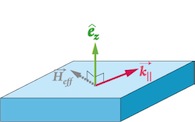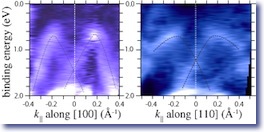A milestone to spin-polarized current
01/04/08 10:00 Filed in: Rashba effect
 Two dimensional electron gases are formed at semiconductor heterojunction. If you apply a potential gradient perpendicular the junction plane, a spin-orbit interaction in proportion to the potential gradient as well as two-dimensional wavevector k is excerted to the electrons. As a result the electron spin is quantized in the direction perpendicular to both the plane normal and k, thus splitting the energy band. This is called the Rashba-Bychkov effect (or, Rashba effect). An important point is that the “direction” of the spin is inverted when you invert the sign of k.
Two dimensional electron gases are formed at semiconductor heterojunction. If you apply a potential gradient perpendicular the junction plane, a spin-orbit interaction in proportion to the potential gradient as well as two-dimensional wavevector k is excerted to the electrons. As a result the electron spin is quantized in the direction perpendicular to both the plane normal and k, thus splitting the energy band. This is called the Rashba-Bychkov effect (or, Rashba effect). An important point is that the “direction” of the spin is inverted when you invert the sign of k.Because of the inversion asymmetry, the surface has been expected to exhibit similar effect. Actually, high-resolution angle-resolved photoemission study showed a Rashba-type spin splitting in the surface state band on Au(111) in 1996, which had a spin-splitting larger by an order of magnitude than those in heterojunctions. Later, even larger splitting was found on the surfaces of Bi, which has the largest atomic number in non-radioactive elements. Many people thought that this is the largest possible splitting.
 However, when we reinvestigated the large file of the angle-resolved photoemission data for Bi/Ag(001) which was obtained by Nakagawa et al. in early 00’s, we found an evidence of the Rashba-type splitting which was larger by an order of magnitude than those on crystalline Bi surfaces and named it “giant Rashba effect”. Independenly, another research group found a comparably large Rashba splitting in Bi/Ag(111) and reported within a few weeks. The splitting was reproduced by a first-principles calculation. As the splitting is so large that it would be possible to use the effect to fabricate a novel device which can control the spin poralization in macroscopic electric current. (Phys. Rev. B 75, 155409 (2007))
However, when we reinvestigated the large file of the angle-resolved photoemission data for Bi/Ag(001) which was obtained by Nakagawa et al. in early 00’s, we found an evidence of the Rashba-type splitting which was larger by an order of magnitude than those on crystalline Bi surfaces and named it “giant Rashba effect”. Independenly, another research group found a comparably large Rashba splitting in Bi/Ag(111) and reported within a few weeks. The splitting was reproduced by a first-principles calculation. As the splitting is so large that it would be possible to use the effect to fabricate a novel device which can control the spin poralization in macroscopic electric current. (Phys. Rev. B 75, 155409 (2007))